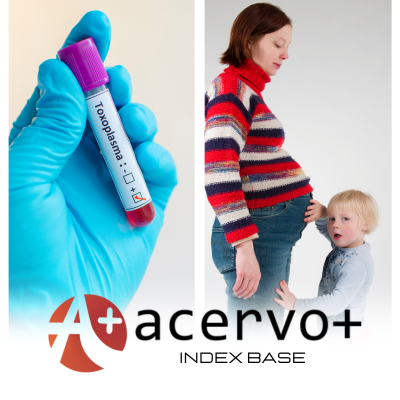Baixa avidez de IgG para Toxoplasma gondii em gestações consecutivas
##plugins.themes.bootstrap3.article.main##
Resumo
Objetivo: Apresentar um caso clínico de uma gestante que permaneceu com teste de avidez baixa para Toxoplasma gondii em duas gestações consecutivas. Detalhamento do caso: G5P2A2, 41 anos, acompanhada no Pré-Natal de Alto Risco devido sorologias para T. gondii com IgM+/IgG+ e teste de avidez realizado com 11 semanas, exibindo 49% de avidez. Trouxe exames da gestação anterior que também mostraram sorologias para T. gondii com IgM+/IgG+ e avidez de IgG baixa (42%). O feto foi avaliado no ambulatório de Medicina Fetal, onde não demonstrou alterações ultrassonográficas. Durante o estudo, testes adicionais foram realizados na paciente, incluindo Enzyme Linked Immuno Sorbent Assay confirmatório, avidez de IgG (59%) e Reação em Cadeia da Polimerase em Tempo Real, com resultado negativo. Evoluiu para parto vaginal espontâneo com 38 semanas, com um recém-nascido saudável. Considerações finais: Observa-se a importância do teste de avidez no manejo da toxoplasmose gestacional e a limitação diagnóstica quando da presença da baixa avidez, sugerindo-se a padronização de prontuários eficazes entre os serviços de saúde com histórico sorológico das gestantes, além da capacitação dos profissionais em protocolos clínicos, como a Nota Técnica (NT) No 100/2022 do Ministério da Saúde, a fim de evitar tratamentos desnecessários.
##plugins.themes.bootstrap3.article.details##
Copyright © | Todos os direitos reservados.
A revista detém os direitos autorais exclusivos de publicação deste artigo nos termos da lei 9610/98.
Reprodução parcial
É livre o uso de partes do texto, figuras e questionário do artigo, sendo obrigatória a citação dos autores e revista.
Reprodução total
É expressamente proibida, devendo ser autorizada pela revista.
Referências
2. BEDNORZ A, et al. Use of Electronic Medical Records (EMR) in Gerontology: Benefits, Considerations and a Promising Future. Clin Interv Aging., 2023; 18: 2171-2183.
3. BOLLANI L, et al. Congenital Toxoplasmosis: The State of the Art. Front Pediatr., 2022; 10: 894-573.
4. BRASIL. Ministério da Saúde. DataSUS. Avaliable:
5. BRASIL. Ministério da Saúde. Secretaria de Atenção Primária à Saúde. Departamento de Saúde Materno-Infantil. Coordenação Geral de Saúde Perinatal e Aleitamento Materno. NOTA TÉCNICA Nº 100/2022 - CGSPAM/DSMI/SAPS/MS, 2022. Avaliable:
6. BRITO RMM, et al. Genetic diversity of Toxoplasma gondii in South America: occurrence, immunity, and fate of infection. Parasit Vectors, 2023; 16: 461.
7. DUBEY JP, et al. Congenital toxoplasmosis in humans: an update of worldwide rate of congenital infections. Parasitology, 2021; 148: 1406-1416.
8. FELÍN MS, et al. Building Programs to Eradicate Toxoplasmosis Part II: Education. Curr Pediatr Rep., 2022; 10: 93-108.
9. GUNDESLIOGLU OO, et al. Congenital Toxoplasmosis and Long-term Outcomes. Turkiye Parazitol Derg., 2024; 48: 8-14.
10. HEDMAN K, ROUSSEAU SA. Measurement of avidity of specific IgG for verification of recent primary rubella. J Med Virol.,1989; 27: 288-92.
11. KODYM P, et al. Detection of persistent low IgG avidity-an interpretative problem in the diagnosis of acute toxoplasmosis. PLoS One, 2023; 18.
12. LOVE JS, et al. The Parallel Pandemic: Medical Misinformation and COVID-19: Primum non nocere. J Gen Intern Med., 2020; 35: 2435-2436.
13. MANDELBROT L, et al. Toxoplasmose pendant la grossesse: proposition actuelle de priseen charge pratique. Gynecol Obstet Fertil Senol., 2021; 49: 782-791.
14. MARGONATO FB, et al. Toxoplasmosis in pregnancy: diagnosis, treatment and the importance of clinical protocol. Rev. Bras. Saúde Matern. Infant., 2007; 7: 381-386.
15. MOSHONOV R, et al. Benefit versus risk of chromosomal microarray analysis performed in pregnancies with normal and positive prenatal screening results: A retrospective study. PLoS One, 2021; 16.
16. ONDURU OG, et al. Evaluation of the level of awareness of congenital toxoplasmosis and associated practices among pregnant women and health workers in Tanzania's Temeke district in Dar es Salaam. Afr Health Sci., 2019; 19: 3027-3037.
17. PIRES LB, et al. Infection of Mouse Neural Progenitor Cells by Toxoplasma gondii Reduces Proliferation, Migration, and Neuronal Differentiation in Vitro. Am J Pathol., 2023;193: 977-994.
18. ROBERT-GANGNEUX F, DARDÉ ML. Epidemiology of and diagnostic strategies for toxoplasmosis. Clin Microbiol Rev., 2012; 25: 264-96.
19. TEIMOURI A, et al. Role of Toxoplasma gondii IgG Avidity Testing in Discriminating between Acute and Chronic Toxoplasmosis in Pregnancy. J Clin Microbiol., 2020; 58.
20. TORK M, et al. Design and optimization of IgG avidity test for differentiating acute from chronic human toxoplasmosis: A systematic review and meta-analysis. Exp Parasitol., 2025; 268: 108883.
21. VARGAS-VILLAVICENCIO JA, et al. Anti-Toxoplasma gondii IgM Long Persistence: What Are the Underlying Mechanisms? Microorganisms, 2022; 10: 1659.
22. WHITE MD, et al. Selective host autophagy is induced during the intracellular parasite Toxoplasma gondii infection controlling amino acid levels. mSphere., 2024; 9.
23. ZHOU Y, et al. Novel paradigm enables accurate monthly gestational screening to prevent congenital toxoplasmosis and more. PLoS Negl Trop Dis., 2024; 18.

